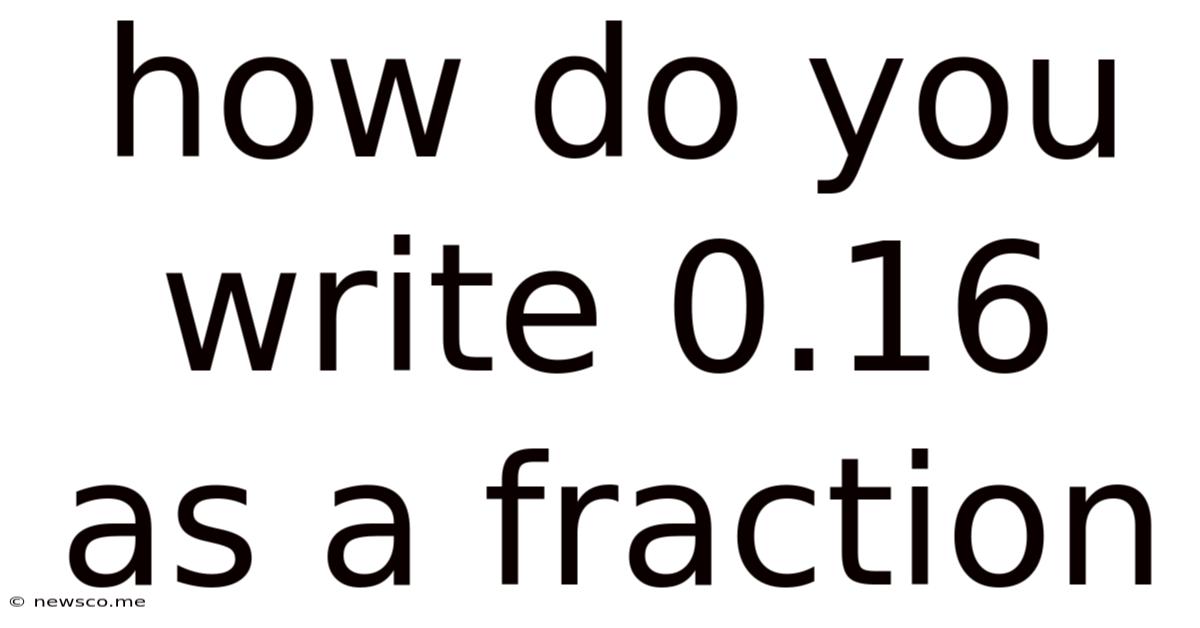How Do You Write 0.16 As A Fraction
News Co
Apr 08, 2025 · 4 min read

Table of Contents
How Do You Write 0.16 as a Fraction? A Comprehensive Guide
Converting decimals to fractions might seem daunting at first, but with a structured approach, it becomes a straightforward process. This comprehensive guide will walk you through various methods to express 0.16 as a fraction, explaining the underlying concepts and providing valuable insights into decimal-to-fraction conversions. We'll also explore related concepts to solidify your understanding.
Understanding Decimals and Fractions
Before diving into the conversion, let's briefly revisit the fundamental concepts of decimals and fractions.
Decimals: Decimals represent parts of a whole number using a base-ten system. The digits to the right of the decimal point represent tenths, hundredths, thousandths, and so on. For example, in 0.16, the '1' represents one-tenth (1/10) and the '6' represents six-hundredths (6/100).
Fractions: Fractions represent parts of a whole number as a ratio of two integers – the numerator (top number) and the denominator (bottom number). The denominator indicates the total number of equal parts, and the numerator indicates how many of those parts are being considered. For example, 1/2 represents one out of two equal parts.
Method 1: Using the Place Value Method
This is the most straightforward method for converting terminating decimals (decimals that end) to fractions.
Steps:
-
Identify the place value of the last digit: In 0.16, the last digit (6) is in the hundredths place.
-
Write the decimal as a fraction with the denominator reflecting the place value: Since the last digit is in the hundredths place, the denominator will be 100. Thus, 0.16 can be written as 16/100.
-
Simplify the fraction: To simplify a fraction, find the greatest common divisor (GCD) of the numerator and the denominator. The GCD of 16 and 100 is 4. Divide both the numerator and denominator by the GCD:
16 ÷ 4 = 4 100 ÷ 4 = 25
Therefore, 0.16 as a fraction is 4/25.
Method 2: Using the Power of 10 Method
This method is similar to the place value method but emphasizes the concept of powers of 10.
Steps:
-
Write the decimal as a fraction over a power of 10: 0.16 can be written as 16/100. Note that 100 is 10².
-
Simplify the fraction: As shown in Method 1, simplifying 16/100 gives us 4/25.
Method 3: Understanding Equivalent Fractions
This method reinforces the concept that many fractions can represent the same value.
Steps:
-
Find an equivalent fraction: We already know that 0.16 = 16/100. We can find an equivalent fraction by dividing both the numerator and denominator by their GCD (4).
-
Simplify to the lowest terms: Dividing both by 4 gives us 4/25, the simplest form of the fraction.
Why Simplifying Fractions is Important
Simplifying fractions is crucial for several reasons:
-
Clarity: Simplified fractions are easier to understand and interpret. 4/25 is more readily grasped than 16/100.
-
Comparison: Comparing simplified fractions is easier than comparing unsimplified fractions.
-
Calculations: Simplifying fractions makes subsequent calculations simpler and less prone to errors.
Converting Other Decimals to Fractions
The methods described above can be applied to convert other terminating decimals to fractions. For example:
- 0.75: The last digit is in the hundredths place, so it's 75/100. Simplifying this gives 3/4.
- 0.2: The last digit is in the tenths place, so it's 2/10. Simplifying this gives 1/5.
- 0.005: The last digit is in the thousandths place, so it's 5/1000. Simplifying this gives 1/200.
Dealing with Repeating Decimals
Converting repeating decimals (decimals with a pattern that repeats infinitely) to fractions requires a slightly different approach. This involves solving an equation. We won't delve into this here, as 0.16 is a terminating decimal.
Practical Applications of Decimal-to-Fraction Conversions
Converting decimals to fractions is a fundamental skill with numerous practical applications in various fields:
-
Baking and Cooking: Recipes often require precise measurements, and fractions are frequently used.
-
Engineering and Construction: Accurate measurements and calculations are crucial, and fractions provide precision.
-
Finance and Accounting: Dealing with percentages and proportions necessitates a strong understanding of fractions and decimals.
-
Data Analysis and Statistics: Fractions are frequently used in representing proportions and probabilities.
-
Everyday Life: Many everyday situations involve dividing quantities, making an understanding of fractions essential.
Advanced Techniques and Further Exploration
For those seeking a deeper understanding, exploring concepts like continued fractions and the relationship between decimal expansions and rational numbers can offer a richer mathematical perspective. These topics, however, are beyond the scope of this introductory guide.
Conclusion
Converting 0.16 to a fraction is a straightforward process, primarily involving identifying the place value and simplifying the resulting fraction. This guide has presented several methods, emphasizing the importance of simplifying fractions for clarity and ease of use. Understanding this conversion is not only essential for mathematical proficiency but also has wide-ranging applications in various real-world scenarios. Mastering this skill provides a solid foundation for more complex mathematical operations and problem-solving. Remember to practice regularly to build confidence and fluency in converting decimals to fractions. The more you practice, the easier and more intuitive this process will become.
Latest Posts
Related Post
Thank you for visiting our website which covers about How Do You Write 0.16 As A Fraction . We hope the information provided has been useful to you. Feel free to contact us if you have any questions or need further assistance. See you next time and don't miss to bookmark.